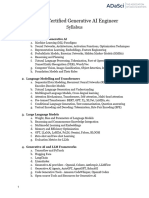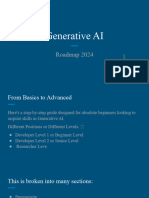0% found this document useful (0 votes)
150 views2 pagesGenerative AI Course
The document outlines a professional tutorial course on Applied Generative AI, consisting of three modules covering Python basics, foundations of generative AI, and prompt engineering techniques. It includes lessons on setting up development environments, understanding generative models, and crafting effective prompts for AI models. Real-world applications and ethical considerations are emphasized throughout the course content.
Uploaded by
Jhon KevinCopyright
© © All Rights Reserved
We take content rights seriously. If you suspect this is your content, claim it here.
Available Formats
Download as PDF, TXT or read online on Scribd
0% found this document useful (0 votes)
150 views2 pagesGenerative AI Course
The document outlines a professional tutorial course on Applied Generative AI, consisting of three modules covering Python basics, foundations of generative AI, and prompt engineering techniques. It includes lessons on setting up development environments, understanding generative models, and crafting effective prompts for AI models. Real-world applications and ethical considerations are emphasized throughout the course content.
Uploaded by
Jhon KevinCopyright
© © All Rights Reserved
We take content rights seriously. If you suspect this is your content, claim it here.
Available Formats
Download as PDF, TXT or read online on Scribd
/ 2

































































































